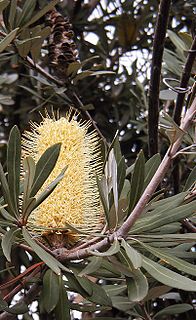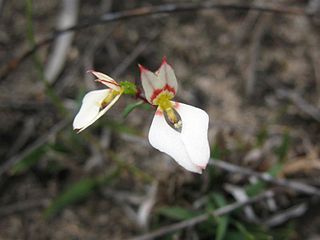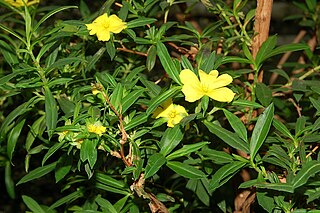
Stylidium is a genus of dicotyledonous plants that belong to the family Stylidiaceae. The genus name Stylidium is derived from the Greek στύλος or stylos, which refers to the distinctive reproductive structure that its flowers possess. Pollination is achieved through the use of the sensitive "trigger", which comprises the male and female reproductive organs fused into a floral column that snaps forward quickly in response to touch, harmlessly covering the insect in pollen. Most of the approximately 300 species are only found in Australia, making it the fifth largest genus in that country. Triggerplants are considered to be protocarnivorous or carnivorous because the glandular trichomes that cover the scape and flower can trap, kill, and digest small insects with protease enzymes produced by the plant. Recent research has raised questions as to the status of protocarnivory within Stylidium.

Adenanthos is a genus of Australian native shrubs in the flowering plant family Proteaceae. Variable in habit and leaf shape, it is the only genus in the family where solitary flowers are the norm. It was discovered in 1791, and formally published by Jacques Labillardière in 1805. The type species is Adenanthos cuneatus, and 33 species are recognised. The genus is placed in subfamily Proteoideae, and is held to be most closely related to several South African genera.

As with other flowering plants, the taxonomy of Banksia has traditionally been based on anatomical and morphological properties of the Banksia flower, fruiting structure and seed, along with secondary characteristics such as leaf structure and growth habit. Increasingly, molecular evidence from DNA is providing important new insights into relationships within the genus and between this and other genera in the Proteaceae.

Banksia nutans, commonly known as nodding banksia, is a species of shrub native to the south coast of Western Australia in the genus Banksia. Growing to a metre (3 ft) tall, it has pale blue-green fine leaved foliage and unusual purple-brown inflorescences which hang upside down rather than grow upright like most other banksias.

Banksia repens, the Creeping Banksia, is a species of shrub in the plant genus Banksia. It occurs on the south coast of Western Australia from D'Entrecasteaux National Park in the west to Mount Ragged in the east.

Banksia scabrella, commonly known as the Burma Road banksia, is a species of woody shrub in the genus Banksia. It is classified in the series Abietinae, a group of several species of shrubs with small round or oval inflorescences. It occurs in a number of isolated populations south of Geraldton, Western Australia, with the largest population being south and east of Mount Adams. Found on sandy soils in heathland or shrubland, it grows to 2 m (7 ft) high and 3 m (10 ft) across with fine needle-like leaves. Appearing in spring and summer, the inflorescences are round to oval in shape and tan to cream with purple styles. Banksia scabrella is killed by fire and regenerates by seed.

Banksia epica is a shrub that grows on the south coast of Western Australia. A spreading bush with wedge-shaped serrated leaves and large creamy-yellow flower spikes, it grows up to 3½ metres (11½ ft) high. It is known only from two isolated populations in the remote south east of the state, near the western edge of the Great Australian Bight. Both populations occur among coastal heath on cliff-top dunes of siliceous sand.

Drosera binata, commonly known as the forked sundew or fork-leaved sundew, is a large, perennial sundew native to Australia and New Zealand. The specific epithet is Latin for "having pairs" - a reference to the leaves, which are dichotomously divided or forked.
In biological nomenclature, a nomen novum, new replacement name is a technical term. It indicates a scientific name that is created specifically to replace another scientific name, but only when this other name cannot be used for technical, nomenclatural reasons ; it does not apply when a name is changed for taxonomic reasons. It is frequently abbreviated, e.g.nomen nov., nom. nov..

The taxonomy of Banksia integrifolia has a long and complex history, the result of confusion caused by the species' great variability, and similarities with some closely related species. The existence of hybrids between B. integrifolia and related species as well as early attempts to classify the species based on dried specimen material have also contributed to the confusion.
This is a timeline of developments in knowledge and understanding of the Australian plant genus Banksia:

Adenanthos sericeus, commonly known as woolly bush, is a shrub native to the south coast of Western Australia. It has bright red but small and obscure flowers, and very soft, deeply divided, hairy leaves.

Stylidium graminifolium, the grass triggerplant, is a dicotyledonous plant that belongs to the genus Stylidium. This species used to belong to the Stylidium graminifolium complex, but the name was conserved for this single species when two others were split from the complex and introduced as new species in 2001. S. graminifolium is endemic to Australia and is one of the Stylidium species with the widest distribution throughout Australia. It is a perennial plant with grass-like leaves and is easily cultivated. It has been considered to be a carnivorous or protocarnivorous plant because it possesses glandular trichomes underneath the flowers that can trap and digest prey.

Levenhookia, also known as the styleworts, is a genus of ten recognized species in the family Stylidiaceae and is endemic to Australia. The genus is restricted to Western Australia almost exclusively with a few exceptions: L. pusilla's range extends into South Australia, L. dubia's range extends through South Australia into Victoria and New South Wales, L. sonderi is native only to Victoria, and L. chippendalei is also found in the Northern Territory.

Adenanthos obovatus, commonly known as basket flower, or, jugflower, is a shrub of the plant family Proteaceae endemic to Southwest Australia. Described by French naturalist Jacques Labillardière in 1805, it had first been collected by Archibald Menzies in 1791. Within the genus Adenanthos, it lies in the section Eurylaema and is most closely related to A. barbiger. A. obovatus has hybridized with A. detmoldii to produce the hybrid A. × pamela. Several common names allude to the prominent red flowers of the species. It grows as a many-stemmed spreading bush up to 1 m (3.3 ft) high, and about 1.5 m (4.9 ft) across, with fine bright green foliage. Made up of single red flowers, the inflorescences appear from April to December, and peak in spring.

Ernest Charles Nelson's taxonomic arrangement of Adenanthos was the first modern-day arrangement of that plant genus. First published in his 1978 Brunonia article "A taxonomic revision of the genus Adenanthos (Proteaceae)", it superseded the arrangement of George Bentham, which had stood for over a hundred years. It was updated by Nelson in his 1995 treatment for the Flora of Australia series of monographs.

Adenanthos cuneatus, also known as coastal jugflower, flame bush, bridle bush and sweat bush, is a shrub of the family Proteaceae, native to the south coast of Western Australia. The French naturalist Jacques Labillardière originally described it in 1805. Within the genus Adenanthos, it lies in the section Adenanthos and is most closely related to A. stictus. A. cuneatus has hybridized with four other species of Adenanthos. Growing to 2 m high and wide, it is erect to prostrate in habit, with wedge-shaped lobed leaves covered in fine silvery hair. The single red flowers are insignificant, and appear all year, though especially in late spring. The reddish new growth occurs over the summer.
George Bentham's taxonomic arrangement of Adenanthos was the first comprehensive taxonomic arrangement of that plant genus. It was published in 1870 in his landmark flora of Australia, Flora Australiensis. It would stand for over a hundred years before being superseded by the 1978 arrangement of Ernest Charles Nelson.

Hibbertia cuneiformis, commonly known as cut-leaf hibbertia, is a shrub species that is endemic to the south-west of Western Australia. It grows to between 1 and 2 metres tall and has yellow flowers which appear from January to March and June to November in the species' native range.

Stylidium glaucum, the grey triggerplant, is a herbaceous plant found along the southern coast of Southwest Australia, West of Albany. The plant attains a height between 0.15 and 0.65 metres. The leaves are lanceolate in form, becoming pointed at the base, and moderately acute at the tip. These are between 20 and 70 millimetres in length and 2 to 9 millimetres in width, are hairless, and have an entire margin. The trivial name of the species, glaucum, refers to the greyish colour of the leaves. The scape is hairless, supporting a racemose arrangement of white or pink flowers that appear from January to May.
















